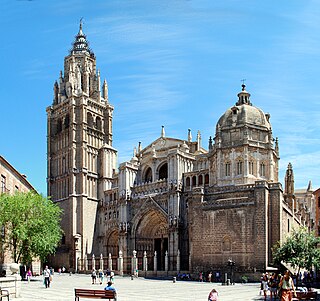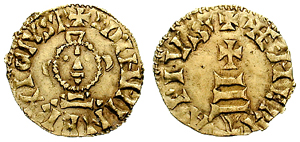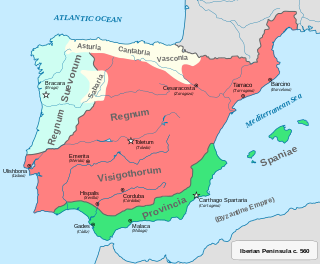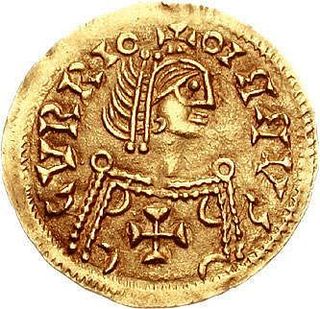
Isidore of Seville was a Hispano-Roman scholar, theologian, and archbishop of Seville. He is widely regarded, in the words of 19th-century historian Montalembert, as "the last scholar of the ancient world".

Reccared I was Visigothic King of Hispania and Septimania. His reign marked a climactic shift in history, with the king's renunciation of Arianism in favour of Roman Christianity in 587.

The Mozarabic Rite, officially called the Hispanic Rite, and in the past also called the Visigothic Rite, is a liturgical rite of the Latin Church once used generally in the Iberian Peninsula (Hispania), in what is now Spain and Portugal. While the liturgy is often called 'Mozarabic' after the Christian communities that lived under Muslim rulers in Al-Andalus that preserved its use, the rite itself developed before and during the Visigothic period. After experiencing a period of decline during the Reconquista, when it was superseded by the Roman Rite in the Christian states of Iberia as part of a wider programme of liturgical standardization within the Catholic Church, efforts were taken in the 16th century to revive the rite and ensure its continued presence in the city of Toledo, where it is still celebrated today. It is also celebrated on a more widespread basis throughout Spain and, by special dispensation, in other countries, though only on special occasions.

Leander of Seville was the Bishop of Seville. He was instrumental in effecting the conversion of the Visigothic kings Hermengild and Reccared to Catholicism. His brother was the encyclopedist Saint Isidore of Seville.

The Third Council of Toledo (589) marks the entry of Visigothic Spain into the Catholic Church, and is known for codifying the filioque clause into Western Christianity. The council also enacted restrictions on Jews, and the conversion of the country to Catholic Christianity led to repeated conflict with the Jews.

From the 5th century to the 7th century AD, about thirty synods, variously counted, were held at Toledo in what would come to be part of Spain. The earliest, directed against Priscillianism, assembled in 400. The "third" synod of 589 marked the epoch-making conversion of King Reccared from Arianism to Orthodox Chalcedonian Christianity. The "fourth", in 633, probably under the presidency of the noted Isidore of Seville, regulated many matters of discipline and decreed uniformity of liturgy throughout the kingdom. The Britonia of Galicia accepted the Latin liturgical rite. The "twelfth" council in 681 assured to the archbishop of Toledo the primacy of Hispania. As nearly one hundred early canons of Toledo found a place in the Decretum Gratiani, they exerted an important influence on the development of ecclesiastical law.

Theudis, was king of the Visigoths in Hispania from 531 to 548.

Witteric was the Visigoth King of Hispania, Septimania and Galicia. He ruled from 603 to 610.

Erwig was a king of the Visigoths in Hispania (680–687).

Ildefonsus or Ildephonsus was a scholar and theologian who served as the metropolitan Bishop of Toledo for the last decade of his life. His Gothic name was Hildefuns. In the Ethiopian Orthodox Tewahedo Church he is known as Dexius based on the Ge'ez translation of legends about his life.
The Sixteenth Council of Toledo first met in Toledo, Spain on 25 April 693. It was the second of three councils convened by Visigothic king Egica.

Spania was a province of the Eastern Roman Empire from 552 until 624 in the south of the Iberian Peninsula and the Balearic Islands. It was established by the Emperor Justinian I in an effort to restore the western provinces of the Empire.
Maximus was the first Visigothic bishop of Zaragoza (Hispania) in 592–619. He was also a theologian and historian.

The Visigothic Kingdom, Visigothic Spain or Kingdom of the Goths occupied what is now southwestern France and the Iberian Peninsula from the 5th to the 8th centuries. One of the Germanic successor states to the Western Roman Empire, it was originally created by the settlement of the Visigoths under King Wallia in the province of Gallia Aquitania in southwest Gaul by the Roman government and then extended by conquest over all of Hispania. The Kingdom maintained independence from the Eastern Roman or Byzantine Empire, whose attempts to re-establish Roman authority in Hispania were only partially successful and short-lived.

Masona or Mausona was the Bishop of Mérida and metropolitan of the province of Lusitania from about 570 until his death. He is famous for exercising de facto rule of the city of Mérida during his tenure as bishop and for founding the first confirmed hospital in Spain.

The Catholic Church in Spain has a long history, starting in the 1st century. It is the largest religion in Spain, with 58.6% of Spaniards identifying as Catholic.

Fulgentius of Cartagena, born in Cartagena in the 6th century and died in 630, was Bishop of Ecija (Astigi), in Hispania.

Suintila, or Suinthila, Swinthila, Svinthila; was Visigothic King of Hispania, Septimania and Galicia from 621 to 631. He was a son of Reccared I and his wife Bado, and a brother of the general Geila. Under Suintila there was an unprecedented peace and unity across the Kingdom of the Visigoths. As a direct result, by 624 the king was able to muster the forces necessary to retake those lands that had been under the control of the Eastern Roman Empire.
The Second Council of Seville was a synod of the ecclesiastical province of Baetica held in 619. It took place in the metropolis of Seville under the Archbishop Isidore. It was the first synod in Baetica since 592. It came shortly after a military campaign by the King Sisebut reincorporated a large part of Baetica into the Visigothic kingdom. This territory had previously been part of the Byzantine province of Spania. Its reincorporation would allow the bishop of Málaga to attend the synod.

Toledo is the repository of more than 2000 years of history. Successively a Roman municipium, the capital of the Visigothic Kingdom, a fortress of the Emirate of Cordoba, an outpost of the Christian Kingdom, and in the 16th century, the temporary seat of supreme power under Charles V. Its many works of art and architecture are the product of three major religions – Judaism, Christianity and Islam.